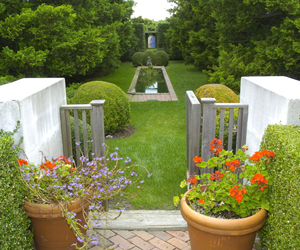

In a year when we’re doing a great deal of thinking before we spend money on our gardens and plants, among other things, I think it’s best to discuss the cost benefits and drawbacks of annuals versus perennials in the garden.
You’ll run into some gardeners who will plant their gardens entirely with annuals and those who will solely use perennials, but it’s said that the best of gardeners use a combination of the two to span all of the color, texture, size and blooming time options. My own personal garden has, well, we’ll get to that later.
As for the difference between annuals and perennials, my 13-year-old would simply tell you that annuals flower once and perennials flower more than once. If it were only that simple. The fact is that annuals go through their entire life cycle in one growing season. The seeds germinate, the foliage and roots grow, the plant flowers and sets seed and shortly thereafter, the plant dies. Perennials, on the other hand, are made to reproduce more than one growing season.
Of course, the actuality of annual life cycles is a bit more complex. If the plant is a tender annual, the seeds will die when subjected to frost or freezing. If the plant is what we call a hardy annual (nearly, but not quite an oxymoron) the plant flowers, sets seed and the seeds fall to the ground—but the seeds are winter hardy and will likely germinate the next spring under the right conditions.
There are even winter annuals, like chickweed, which actually grow under the snow and flower in late winter to early spring. With chickweed, even when the plants are dead, the seed is already sitting on the soil waiting to germinate.
Perennials are quite different. For the most part we don’t rely on their seed for propagation, but their roots. This is not to say that perennials can’t be grown from seed, but most of our modern perennials are essentially clones of their parents. This is how we can be sure that every iris, peony or phlox of the same name is a mirror image of its sibling. This type of propagation is very difficult to accomplish with plants grown from seed.
We loosely define perennials as plants that grow from below ground portions that are usually roots. The shoots emerge from the roots each spring, elongate, produce foliage and then usually flower. During the growing season, the plant rejuvenates the root system, where enough energy is stored over the winter. The shoot system dies at the end of the growing season, goes dormant and then emerges again the next spring.
One of the greatest assets of the perennials is that you buy them once and, for most of them, they return year after year for years and years. This is important to remember when you’re spending $15 or more for a potted perennial as it will give you repeat annual showings and will pay dividends. The dividends come when you divide your perennials and make more—for free. In no time, that one perennial may cost you as little as a similar six-pack of annuals.
Now let me add a bit of confusion to the mix. There are also plants that we call tender perennials, and let us not forget the biennials.
Many gardeners already grow a tender perennial and don’t even know it. This plant has fairly inconspicuous flowers, but we actually grow it for the fruits. It goes by the name of tomato, and in the areas where it’s native, it’s a true herbaceous perennial.
In recent years, many other tender perennials that have tropical origins have been introduced into the summer garden. The great thing about tender perennials is that there is a choice—they can be lifted and brought indoors for the winter or treated as annuals.
Biennials are plants that establish their roots and shoot system (foliage) during the first growing season, but don’t flower. In the second growing season, they flower, then die before the next winter. While hollyhocks are often sold as perennials, they are actually biennials, though from time to time a plant will manage a third year.
What fools many gardeners is that hollyhocks will self-seed. And in the right conditions, the seedlings will result in new plants, giving the appearance that the plant flowers every year.
Delphiniums, especially the taller varieties, are also considered to be biennials or short-lived perennials, another variation on the theme.
Now it’s time for me to admit to my bias. If you haven’t already noticed, I’m a perennial lover. My garden is composed entirely of perennials save for the annual weeds.
Perennials have been my addiction for at least 30 years, but now that I think about it, my father never planted annuals either. If you want a long-term gardening challenge, build a perennial garden that’s blooming and attractive from March through October.
My addiction out in the open, I must say that annuals really do have a strong place in a proper garden. There are times when spaces in a garden simply can’t be filled by perennials, and unless you are a really experienced gardener, there are gaps in the garden that really need to be filled with annuals. These gaps usually occur during the mid-summer period when the summer perennials have finished blooming and the late perennials haven’t started yet. This is when many annuals thrive in the sun and heat and it’s their time of glory.
Annuals also serve a strong function in planters and pots where perennials simply aren’t practical. Many annual varieties are well suited to mass plantings where drifts of color are part of the plan and can be accomplished from the flowers, the foliage or both.
And don’t forget that annuals can be grown from seeds that are started indoors, in situ or from cell packs.
Here’s a suggestion: When the annuals and perennials start to show up on local garden center benches, take a look at the prices. Check out how much a flat of annuals will cost and consider how long they will last and how much space they will take up. Then find a perennial plant that might serve the same function and look at the cost of one plant, remembering that over a few years you can divide it and it may cover that same space as the flat of annuals that would need to be replanted every year.
On an end note this week, I have to pass along a tip for the perennial lovers such as myself who are always trying to find that special and seemingly elusive plant that thrives in the shade. For years I’ve been reading the comments and suggestions of Gene Bush, a man who owns a small mail-order perennial nursery specializing in rare and unusual perennials for the shade. I have to say that Mr. Bush produces a wonderful catalog that’s a great text reference and has some truly unique plants for shade lovers. The nursery is Munchkin Nursery and Gardens in Depauw, Indiana. You can view his online catalog at munchkinnursery.com and you can also sign up for his newsletter on the website.
Keep growing.
Andrew Messinger has been a professional horticulturist for more than 30 years. He divides his time between homes and gardens in Southampton, Westchester and the Catskills. E-mail him at: Andrew@hamptongardener.com. The Hampton Gardener is a registered trademark.
 More Posts from Andrew Messinger
More Posts from Andrew Messinger